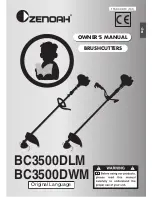
12
at a fault current of 30 mA. Defective RCD plugs
must be replaced by a qualified electrician.
Press the reset key (38) again in order to be able
to start up the machine.
7.3 ON/OFF switch (Fig. 7)
To switch on, press the “1” on the ON/OFF
switch (16).
Before you begin cutting, wait until the cutting
wheel has reached maximum speed and the
cooling water pump (13) has started supplying
the cutting wheel with water.
To switch off, press the “0” on the switch (16).
7.4 90° Cutting (Fig. 8/9)
Loosen the star grip screw (27).
Set the angle stop (5) to 90° and retighten the
star grip screw (27).
Retighten the screws (28) to fasten the angle
stop (5).
Move the machine head (29) to the far end with
the handle (9).
Position the tile against the rail fence (6) on the
angle stop (5).
Switch on the tile cutting machine.
Caution:
Always wait until the cooling water has
reached the cutting wheel (2) first.
Move the machine head (29) slowly and
smoothly forward through the tile with the handle
(9).
Switch off the tile cutting machine after
completion of cutting.
7.5 45° Diagonal cut (Fig. 10)
Set the angle stop (5) to 45°.
Cut as described in 7.4.
7.6 45° Lengthwise cut, “jolly cut” (Fig.11)
Loosen the star grip screw (10).
Tilt the guide rail (7) to the left to 45° on the
angle scale (17).
Retighten the star grip screw (10).
Cut as described in 7.4.
7.7 Changing the diamond cutting wheel
(Fig. 12/13)
Pull out the power plug.
Unscrew the four screws (35) and remove the
safety hood (8) for the blade.
Using the wrench (34), loosen the flange nut in
the direction of rotation of the cutting wheel (2).
(Caution: Left-hand screw-thread.) To do so,
place the wrench (31) on the motor shaft and
apply counterpressure.
Remove the outer flange (36) and cutting wheel
(2).
Clean the mounting flange thoroughly before
fitting the new cutting wheel.
Fit the new cutting wheel by following the above
procedures in reverse and then tighten.
Caution:
Pay attention to the direction of rotation
of the cutting wheel!
Mount the safety hood (8) for the blade again.
8. Operating the laser (Fig. 15-19)
8.1 Stationary operation (Fig. 15/16)
To switch on:
Move the ON/OFF switch (46) to the
“I” position.
To switch off:
Move the ON/OFF switch (46) to the
“0” position.
Switch on the laser (45). A laser line is projected
onto the material you wish to process, providing an
exact guide for the cut. You can additionally adjust
the laser with the screw (47). To do so, undo the
screw (47) by a few turns. The laser (45) can now be
moved and adjusted vertically and horizontally on the
adapter (48). Tighten screw (47) again when you are
satisfied with the adjustment.
8.2 Use as a laser level unit (Fig. 15-18)
Remove the screw (47). The laser (45) can now be
taken off the adapter (48) and used as an external
laser level unit. The laser (45) is equipped with two
spirit levels (49) and can therefore be adjusted both
horizontally and vertically. The base plate (50) of the
laser is magnetic, enabling it to be secured on
suitable surfaces.
See Figures 17 and 18 for two examples of use.
8.3 Replacing the battery
Unscrew the 4 screws (51) and remove the base
plate (50). Take out the old batteries and replace
with new ones. Then screw the base plate (50) back
on.
Dismantle the laser before you clean the machine
with water.
GB
Anleitung NRF 800L_SPK1 25.09.2006 8:48 Uhr Seite 12















































